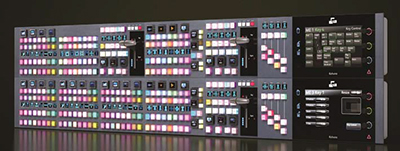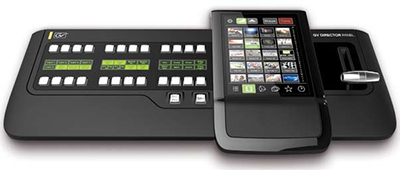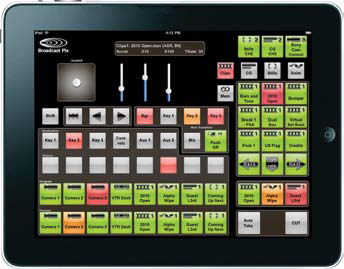Tradition Battles Technology in Switcher Facelifts

Snell Kahuna Maverick
SAN FRANCISCO—Put an experienced switcher operator in front of a sprawling professional broadcast switcher—even in the dark—and odds are he or she could still pull together a show.
That testifies to the solid, steadfast design of a traditional production switcher. Buttons here, fader bar there.
What the next five years holds, however, is not as clear. The dominance of standard tactile controls on the modern- day production switcher may begin to waver in favor of trends like integrated touchscreens and standalone tablet apps, whose ease-of-use features are being considered for their speed and agility.
The right balance seems to be a machine that smartly combines speed and agility while tapping into an operator’s skill and experience. So what does this next-generation switcher look like?
PART ART, PART SCIENCE
What’s clear is that the physical design of a professional production switcher is part art and part science, a methodical and precise process that takes into account speed, intuitiveness and—more recently—an operator’s creative capabilities.

GV Director Nonlinear Live Production System “One of the overwhelming responses that we got was for a solution that allows more creative operators to go out and produce high-quality productions,” said David Sabine vice president of the switcher product line at Grass Valley in San Francisco. “[They wanted to do it] without the traditional need for technical operators to convert those creative desires into a technically produced output.”
Get the TV Tech Newsletter
The professional video industry's #1 source for news, trends and product and tech information. Sign up below.
That meant rethinking the design and layout process of the company’s GV Director switcher. “We wanted to examine some of these long-held workflows in the terms of modern technology and how to solve things with a fresh set of eyes,” said David Griggs, embedded software manager for switchers at Grass Valley. The company looked at the evolution that has taken place in post production design, and built the Director with a smart control surface with touchscreen panel.
Workflow was the starting point, he said.
“When you think about live production in its simplest form, it’s simply a building block to create an output,” Griggs said. “In a traditional switcher you have some technical and specific resources to do that. We wanted to create a ‘PowerPoint’ [solution] for live production—an ability to drag-and-drop live elements—simply by thinking of those as layers and layering on top, and it’s been surprisingly intuitive.”
There’s also a call from smaller production houses to pull off professional-looking events, regardless of the size of the event, Griggs said. “There is an increased desire to find a smarter way to produce a higher-quality production,” he said.
HYBRID SOLUTIONS
Others, however, point to the success of traditional tactile control panels.
“My general sense is that the tactile properties of physical switches on a control surface remain essential for multicamera and multisource complex live production,” said Karl Paulsen, CTO of systems integrator Diversified Systems and columnist for TV Technology. “That may be changing for less high-profile systems.”
Virtual panels may find a foothold, he said, in cases where managers seem to support the flexibility of mini-control systems that can be adapted based upon the environment they work in.
That’s what Steve Ellis, CEO of Broadcast Pix in Billerica, Mass., has seen as well. “At one point in my career, I ran a fairly large post house and we had switchers in every room. That industry doesn’t exist anymore.” Ellis sees the production switcher evolving into a hybrid of solutions that takes into account what’s happening in the real world. “Production teams are getting smaller,” he said. “So we’re all trying to create solutions that allow [operators] to automate the process.”
Broadcast Pix’s foray into the touchscreen space includes the iPixPanel app for the iPad, which can control the Flint, Mica or Granite integrated production solutions. Via an iPad, the system can switch cameras, add key layers, control a CG or operate a robotic camera via a virtual joystick. The iPixPanel can be used as the sole control surface or as a portable panel. “A lot of people prefer the old switcher, the keys and the physical switcher,” Ellis said. “But part of that was because of the complexity of the situation. Today you can do very complex types of productions and do it with a touch screen.”
There is also continued interest in PC-like systems with built-in switcher panels that are mouse- or touch-driven, as well as increased use of a combination tablet for switching and reviewing dailies in a of production studio, Paulsen said. Production switchers have been a fairly traditional work surface since the beginning of time, and have stayed fairly basic in terms of how to select inputs and outputs, how to call up a key and how to do a mix,” said Jay Shinn, account manager for For-A in Ft. Lee, N.J. “But that’s beginning to change as some of the display technologies become more affordable and as the customer base evolves as well.”

Broadcast Pix iPix touchscreen panel That customer base may be the tipping point on how quickly these technologies evolve. “The user community is used to a certain style of operating, and most users like the traditional panel,” Shinn said. “Some are resistant to changing how the workflow is occurring, but we are beginning to see a new generation of operators that are more willing to take on new technology to take into their production workflow.”
This spring For-A announced a new feature in its HVS line of switchers that features a built-in Web server to allow users to adjust settings from a PC or tablet terminal.
This new display technology gives operators an advantage, Shinn said. “In front of a control panel like this, you can give other people the ability to participate in the workflow remotely with wireless devices; you’re not tethered to a wire or a traditional control panel.”
In general, the professional audio/video world seems to be adopting to these new forms of soft/virtual panels faster than the mainstream broadcast or mobile production world, Paulsen said. “So I’d expect broadcast manufacturers to steadily increase experimentation over time.”
Tapping into the different ways that operators work was a key component in building the module-based Snell Kahuna Maverick control surface, which allows users to deploy modules in a variety of configurations depending on desk space. “But each element of the Maverick still conforms to the way that people understand a switcher to work,” said John Carter, senior product manager for U.K.-based Snell.
What will drive future switcher design? It’s apt to be a push from the creative, a push back from the technical and a demand from operators that regardless of the final design, the technology will respond as intended.
“I think over the longer term, we’ll break away from a definite physical set of resources,” Grass Valley’s Griggs said. “The industry has stopped doing the indentured training of technical people. It would be nice to think that even for our larger switchers, we have a new creative paradigm to suit people who are in our industry today.”
Susan Ashworth is the former editor of TV Technology. In addition to her work covering the broadcast television industry, she has served as editor of two housing finance magazines and written about topics as varied as education, radio, chess, music and sports. Outside of her life as a writer, she recently served as president of a local nonprofit organization supporting girls in baseball.

